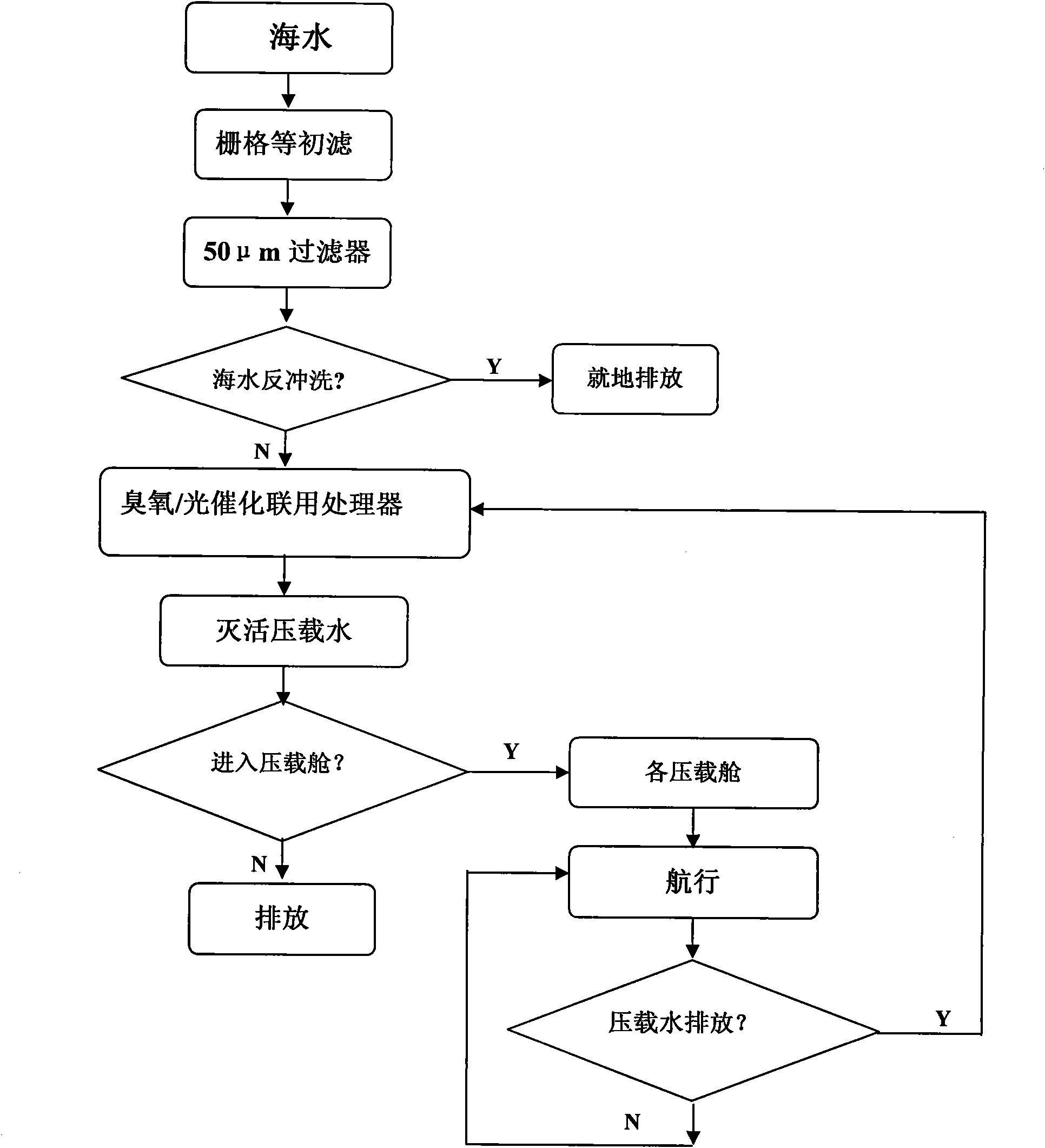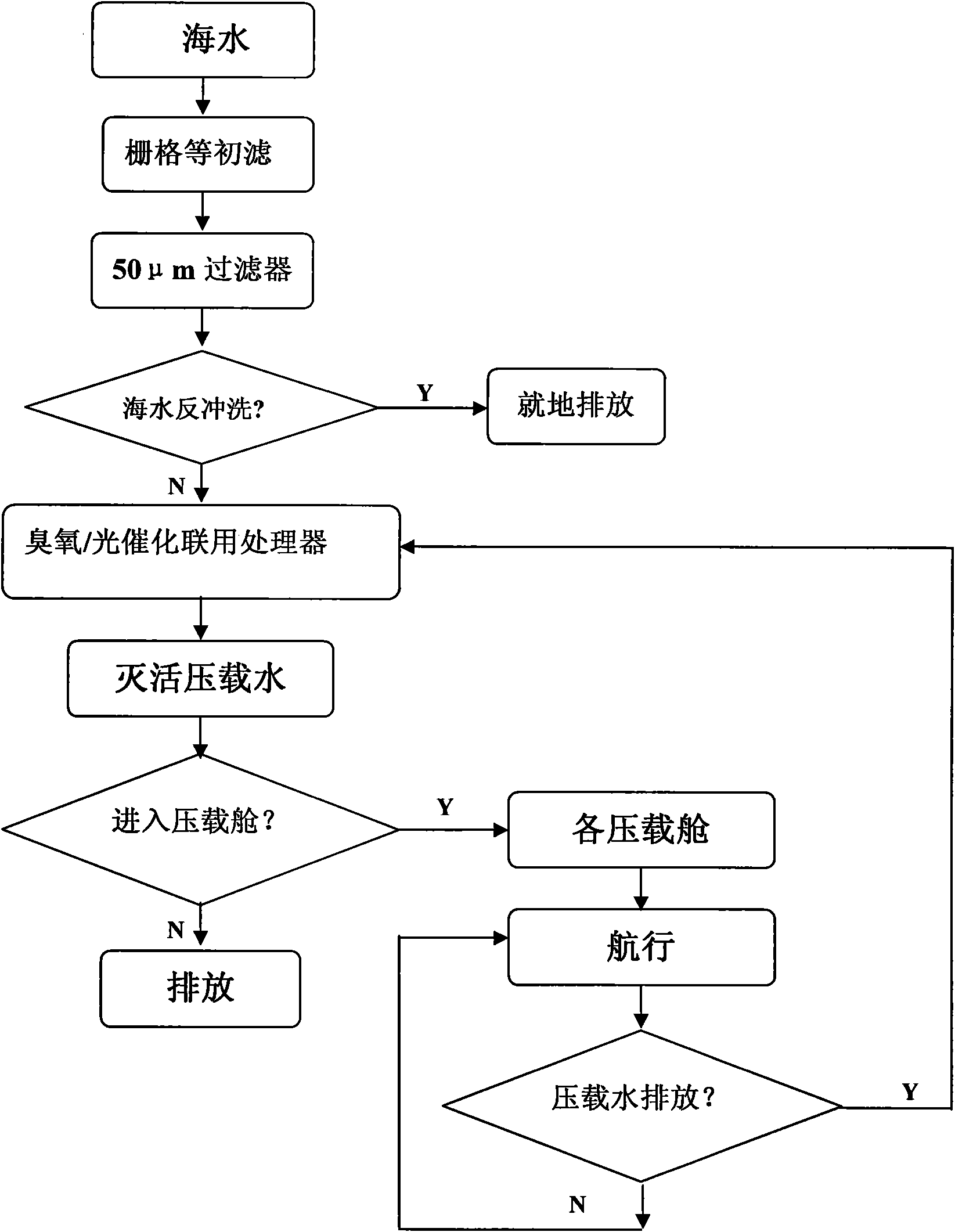Ship ballast water processing method combining ozone and photocatalysis
A technology for ship ballast water and treatment methods, which is applied in the field of ballast water treatment technology, can solve the problems of seawater secondary pollution, large equipment volume, and poor treatment effect, and achieve wide application range, small equipment volume, and small negative impact Effect
- Summary
- Abstract
- Description
- Claims
- Application Information
AI Technical Summary
Problems solved by technology
Method used
Image
Examples
Embodiment 1
[0036] The ballast water taken from the Yangshan Deepwater Port was first filtered through a filter with a pore size of 50 μm. The concentration of algae with a diameter of less than 50 μm was 2.46×103 / ml, and the concentration of bacteria was 9.22×102 / ml. Plate ozone generator (ozone output > 10g / h), low-pressure mercury lamp with a dominant emission wavelength of 254nm, and a thin-film TiO2 photocatalyst prepared on an industrially pure titanium sheet as a supporting substrate for ozone / photocatalytic combined processor treatment 5 seconds, control the dosage of ozone to 0.5mg / L. Use the algae counting method and the ultraviolet-visible spectrometer method to detect the number of algae and bacteria, wherein the algae and bacteria with a diameter of less than 50 μm are not detected, and the killing rate is 99.99%. The ballast water treated by the method of the present invention can reach international standards. Indicators specified by the International Maritime Organization ...
Embodiment 2
[0038] After the ballast water taken from Ningbo Xiangshan Port is filtered through a filter with a pore size of 50 μm, the concentration of aquatic organisms with a diameter of less than 50 μm such as protozoa, algae, bacteria, and spores exceeds 4.01×104 / ml, and the COD of the ballast water It is 2.37mg / L. After adopting a commercially available ceramic plate ozone generator (ozone output > 10g / h), a low-pressure mercury lamp emitting a dominant wavelength of 254nm, and a thin-film TiO2 light prepared on a sponge-like porous ceramic as a supporting substrate After the photocatalytic strong oxidation reactor of the catalyst is treated for 5 seconds, the ozone dosage is controlled to be 0.5-0.7mg / L. Protozoa, algae and bacteria were detected, and the results were not detected, and the killing rate reached 99.99%; in the ballast water after the 3-day bacterial culture method, bacteria less than 50 μm were not detected, which proves that the method of the present invention can co...
Embodiment 3
[0040] After the ballast water taken from Ningbo Xiangshan Port is filtered through a filter with a pore size of 50 μm, the concentration of aquatic organisms with a diameter of less than 50 μm such as protozoa, algae, bacteria, and spores exceeds 3.98×104 / ml, and the COD of the ballast water is 1.62mg / L, by using a commercially available ceramic plate ozone generator (ozone output > 10g / h), a low-pressure mercury lamp with a dominant emission wavelength of 254nm, and a thin-film type prepared on a glass ball with a diameter of 5mm as a supporting substrate After 10 seconds of treatment in the photocatalytic strong oxidation reactor of TiO2 photocatalyst, the dosage of ozone is controlled to be 0.6-0.8mg / L. Protozoa, algae and bacteria were detected, and the results were not detected, and the killing rate reached 99.99%; in the ballast water after the 3-day bacterial culture method, bacteria less than 50 μm were not detected, which proves that the method of the present inventio...
PUM
| Property | Measurement | Unit |
|---|---|---|
| wavelength | aaaaa | aaaaa |
| diameter | aaaaa | aaaaa |
| clearance rate | aaaaa | aaaaa |
Abstract
Description
Claims
Application Information
 Login to View More
Login to View More - R&D
- Intellectual Property
- Life Sciences
- Materials
- Tech Scout
- Unparalleled Data Quality
- Higher Quality Content
- 60% Fewer Hallucinations
Browse by: Latest US Patents, China's latest patents, Technical Efficacy Thesaurus, Application Domain, Technology Topic, Popular Technical Reports.
© 2025 PatSnap. All rights reserved.Legal|Privacy policy|Modern Slavery Act Transparency Statement|Sitemap|About US| Contact US: help@patsnap.com


